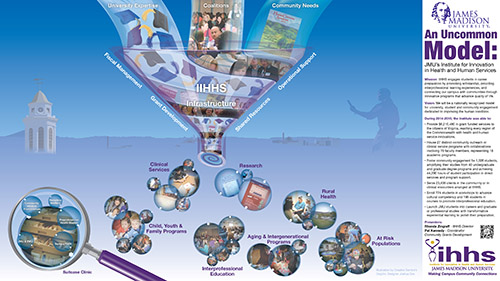An Uncommon Model
IIHHS Depicts Engagement in Uncommon Graphic Model
NewsBy: Dina Manco '16
Posted: December 7, 2015

Institute for Innovation in Health and Human Services (IIHHS) Director Rhonda Zingraff and IIHHS Coordinator of Community Grants Development Pat Kennedy wanted to illustrate how the Institute is a hub of community action. The opportunity to do so arose when the Engagement Scholarship Consortium released a call for proposals to be presented at their annual conference. For this project, Zingraff and Kennedy along with the IIHHS leadership team discussed how they could best portray the goals of the Institute and the ways it influences the local community. Subsequently, “An Uncommon Model” poster was born with the assistance of Creative Services Graphic Designer Joshua See.
Both the unusual infrastructure of IIHHS and the unique design of the poster are reflected in the title “An Uncommon Model.” The poster consists of a large graphic with a typography section on the right-hand side. The content in the written section is detachable from the graphic in order to add new information and statistics about grant funds and JMU involvement since this information changes every year.
The graphic features the Blue Ridge Mountains in the background and JMU’s Wilson Tower peering out of the background on the far left. The center of the poster presents a translucent funnel where the major influences of IIHHS swirl together linking University Expertise, Community Needs Assessments, and Community Coalitions together. The bottom of the funnel shows programs depicted as bubbles with specific topics and services the Institute offers.
Zingraff states, “If you put a magnifying glass over any bubble, you would not just see a single partnership, you would see a network of people and organizations that joined together in order to make these programs have lasting benefit.”
IIHHS has twenty seven different outreach programs. The Institute fosters innovations that address youth development, at-risk populations, and aging services.
Zingraff comments, “We have the talent here to do grant development, to do fiscal management for all the budgets and grants involved, to provide the opportunities for programs to share resources and expertise so they don’t have to achieve everything independently, and to provide overall operations support for the building.”
Kennedy explains, “Community engagement activities are happening on other campuses, but they tend to be isolated in departments, and faculty members create something…for students to have community engagement while they’re in a particular class.” When the course ends, so may the community involvement. The difference with IIHHS is its projects are ongoing—some have been in place for up to 12 years. The poster’s funnel demonstrates this infrastructure. Rising programs looking to engage in outreach can utilize the Institute’s resources.
Zingraff adds, “[The university knows] people here already have connections in the community, already have connections on grant writing with granting agencies, already have experience on how to get things up and rolling…if you have this to help you come up with a program that is a big improvement over feeling alone and wondering ‘How am I going to find money, how am I going to find help in order to sustain it?’”
The visual representation of IIHHS serves to highlight the Institute and enhance the mission of JMU as an engaged university that serves the local community. With resources for students, professors, and the community, it aims to create a pathway for long-standing relationships between the JMU campus and the surrounding urban and rural areas of the region.

